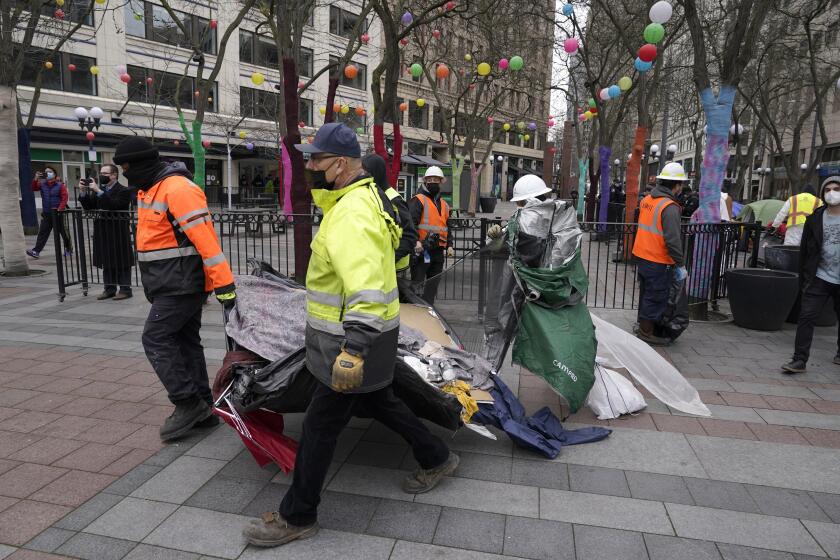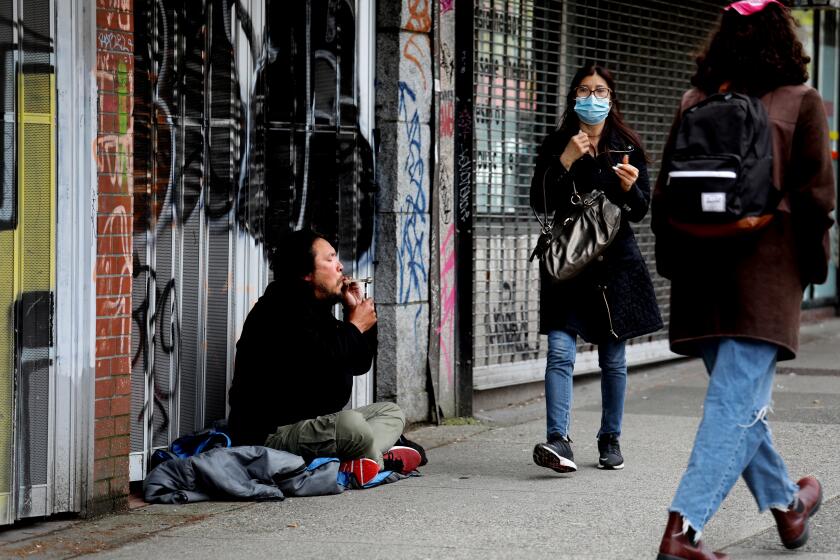‘Not safe anymore’: Portland confronts the limits of its support for homeless services
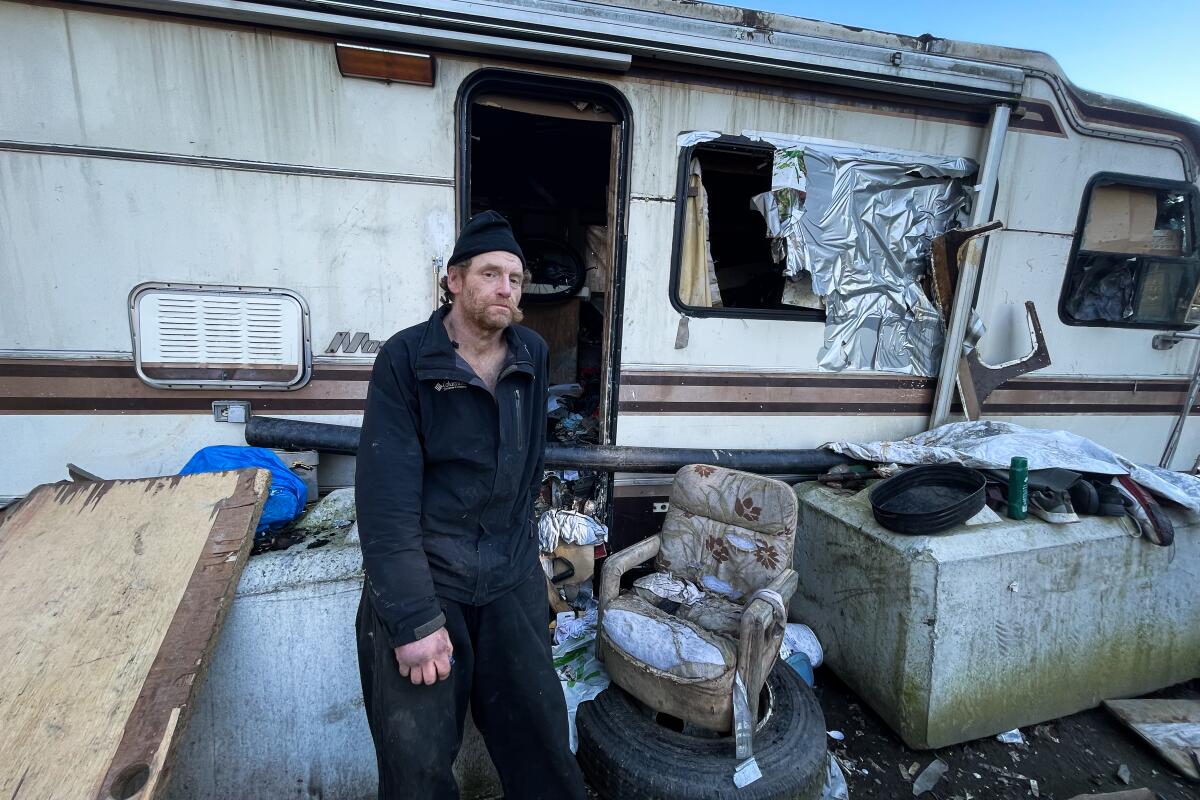
- Share via
PORTLAND, Ore. — Michelle Farris never expected to become homeless, but here she was, sifting through garbage and towering piles of debris accumulated along a roadway on the outskirts of northeast Portland. Farris, 51, has spent much of her adult life in Oregon and has vivid memories of this area alongside the lumbering Columbia River when it was pristine, a place for quiet walks.
Now for miles in both directions, the roadside was lined with worn RVs and rusted boats doubling as shelter. And spilling out from those RVs, the trash and castoffs from this makeshift neighborhood also stretched for miles, making for a chaos that unnerved her.
Broken chairs, busted-up car parts, empty booze bottles, soiled blankets, discarded clothes, crumpled tarps. Every so often, it was more than she could bear, and she attacked the clutter around her own RV, trying furiously to organize the detritus into piles.
“Look at all this garbage out here — it used to be beautiful nature, but now it’s all polluted,” she said, as the stench of urine and burned rubber hung in the damp air. “The deer and river otters and beavers have to live with all this garbage.”
She paused a moment, glancing in the distance at a snow-capped Mt. St. Helens. A line of RVs dotted the horizon.
Portland’s homelessness problem now extends well beyond the downtown core, creating a crisis of conscience for this fiercely liberal city that for years has been among America’s most generous in investing in homeless support services. Tents and tarps increasingly crowd the sidewalks and parks of Portland’s leafy suburban neighborhoods. And the sewage and trash from unsanctioned RV encampments pollute the watersheds of the Willamette and Columbia rivers.
The RV encampments have emerged as havens of heroin and fentanyl use, a community of addiction from which it is difficult to break free, according to interviews with dozens of camp inhabitants. Even while reflecting on their ills, many of the squatters remarked on the surprising level of services available for people living homeless in Portland, including charity food deliveries, roving nurses, used-clothing drop-offs and portable bathrooms — even occasional free pump-outs for their RV restrooms, courtesy of the city.

Giant disposal containers for used syringes are strategically located in areas with high concentrations of homeless people. Red portable toilets pepper retail corridors as well as some tony family-oriented neighborhoods. In parts of the city, activists have nailed small wooden cupboards to street posts offering up sundries such as socks, tampons, shampoo and cans of tuna.
“Portland makes it really easy to be homeless,” said Cindy Stockton, a homeowner in the wooded St. Johns neighborhood in north Portland who has grown alarmed by the fallout. “There’s always somebody giving away free tents, sleeping bags, clothes, water, sandwiches, three meals a day — it’s all here.”
Portland, like Los Angeles, Sacramento and much of the San Francisco Bay Area, has experienced a conspicuous rise in the number of people living in sprawls of tents and RVs, even as these communities have poured millions of tax dollars — billions, collectively — into supportive services. That spending has moved some people off the streets and helped many others survive, but it hasn’t disrupted the broader cycle of homelessness in any meaningful way.
The mayor of Portland, Ore., recently banned camping on the sides of certain roadways, and officials are exploring other aggressive options to combat homelessness.
The city offers a textbook example of the intensifying investment. In 2017, the year Mayor Ted Wheeler, a Democrat, took office, Portland spent roughly $27 million on homeless services. Under his leadership, funding has skyrocketed, with Wheeler this year pushing through a record $85 million for homeless housing and services in the 2022-23 fiscal year.
Voters in the broader region of Multnomah, Washington and Clackamas counties in 2020 approved a tax measure to bolster funding for homelessness. The measure, which increases taxes for higher-income businesses and households, is expected to raise $2.5 billion by 2030.
But as debate roils about how best to spend the growing revenue, Portland also offers a sobering lesson in the hard knot of solving homelessness, once it hits a crisis level.
What Portland has not managed to do is fix the housing piece of the homeless equation. The city has about 1,500 shelter beds, not nearly enough to meet the need. It lacks ready access to the kind of subsidized permanent housing, supported by case managers, medical care, job placement and addiction treatment, that has proved successful in cities such as Houston in moving people off the streets.
Nor has Portland come close to replenishing the stocks of affordable housing lost as its neighborhoods have gentrified and redeveloped.
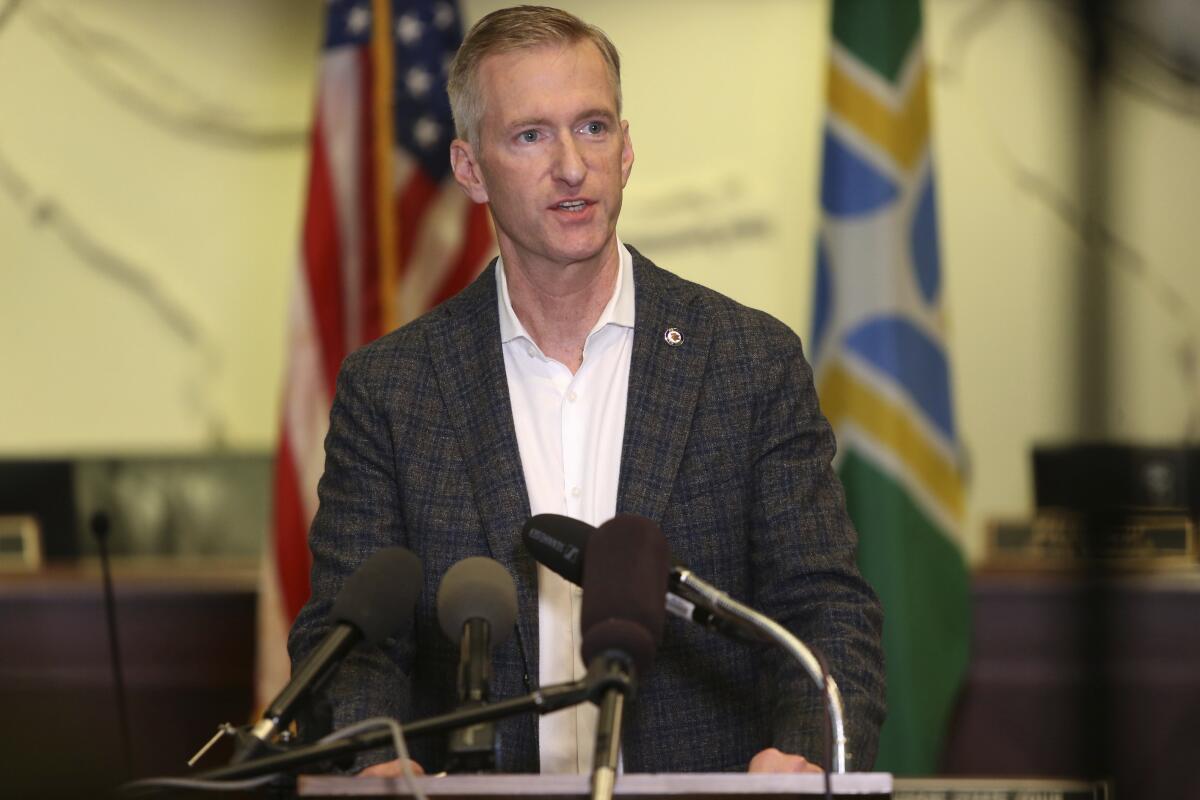
Wheeler rejects claims that Portland has attracted homeless people to the region with its array of day-to-day services. But he acknowledged that the city does not have enough housing, detox facilities or mental health care options to meet the need: “We are not appropriately scaled to the size and scope of the problem.”
“And, you know, is that our fault?” he said, calling for more state and federal investment. He pointed to “a foster care system that delivers people to the streets when they age out,” and a prison system that releases people without job training or connections to community services.
Meanwhile, the mission has grown more daunting. The 2019 homeless count in the Portland region, a one-night tally, found more than 4,000 people living in shelters, in vehicles or on the streets. This year, that number stands at roughly 6,000, according to the mayor’s office, a 50% surge that is, nonetheless, widely considered an undercount.
::
South of the Columbia River in an industrial section of north Portland, not far from Delta Park’s bustling soccer and softball complex, another RV encampment lines a side street that juts off the main drag. Many of the camp’s inhabitants have parked here for years and are protective of their turf. Group leaders hold down the numbers — no more than 20 or so RVs. And they enforce tidiness rules, sometimes using physical force, so as not to draw undue attention from city code enforcement.
“We’ve maintained a symbiotic relationship with the businesses here,” said Jake Caldwell, 38, who lives in an RV with his girlfriend, Sarah Bennett. “We keep it clean and orderly, and they let us stay.”
Nearly all those interviewed in the encampments said they have noticed a sharp increase in the number of people living in RVs in Portland, a trend playing out up and down the West Coast. Some of the newcomers lost their jobs in pandemic-related shutdowns and couldn’t keep up with rent or mortgage payments. Others, already living on the edge, described being kicked off couches by family or friends as COVID-19 made cramped living situations dangerous.
They’ve joined the ranks of the more entrenched homeless population and people who can no longer afford to live here. Minimum-wage earners who grew up in the region only to be priced out of the housing market as wealthier people moved in. People who lost their financial footing because of a medical crisis. People struggling with untreated mental illness. People fresh out of prison.
And an overwhelming theme: people left numb and addled by a drug addiction. Some lost jobs and families while struggling with drug and alcohol use and ended up on the streets; others started using after landing on the streets.

“It’s like a hamster wheel — once you get out here, it’s so hard to get out,” said Bennett, 30, a heroin addict. “My legs are so swollen from shooting heroin into the same place for so long, I’m worried I have a blood clot.
“I feel like I’m wasting my life away.”
Most of the RVers interviewed in these north Portland encampments openly discussed their addictions. But they routinely cited a lack of affordable housing as a key factor in their predicament and blamed homelessness for exacerbating their mental and physical ailments.
“You get severe depression and PTSD from being out here,” Bennett said.
Still, she and others consider themselves lucky to have scored an RV, which even broken down can cost a few thousand dollars. One camp dweller said he bought his using unemployment funds after losing his job in the pandemic. Caldwell and Bennett, who both use and deal heroin, said they purchased theirs with help from drug money. Some RVs are stolen; others were donated or simply taken over after being abandoned.
The benefits, RVers said, are innumerable compared with tent living: Portland weather is notoriously soggy, and RVs offer more reliable shelter. They have doors that lock instead of zip, a better theft deterrent. Women feel less vulnerable. It’s easier to organize possessions.
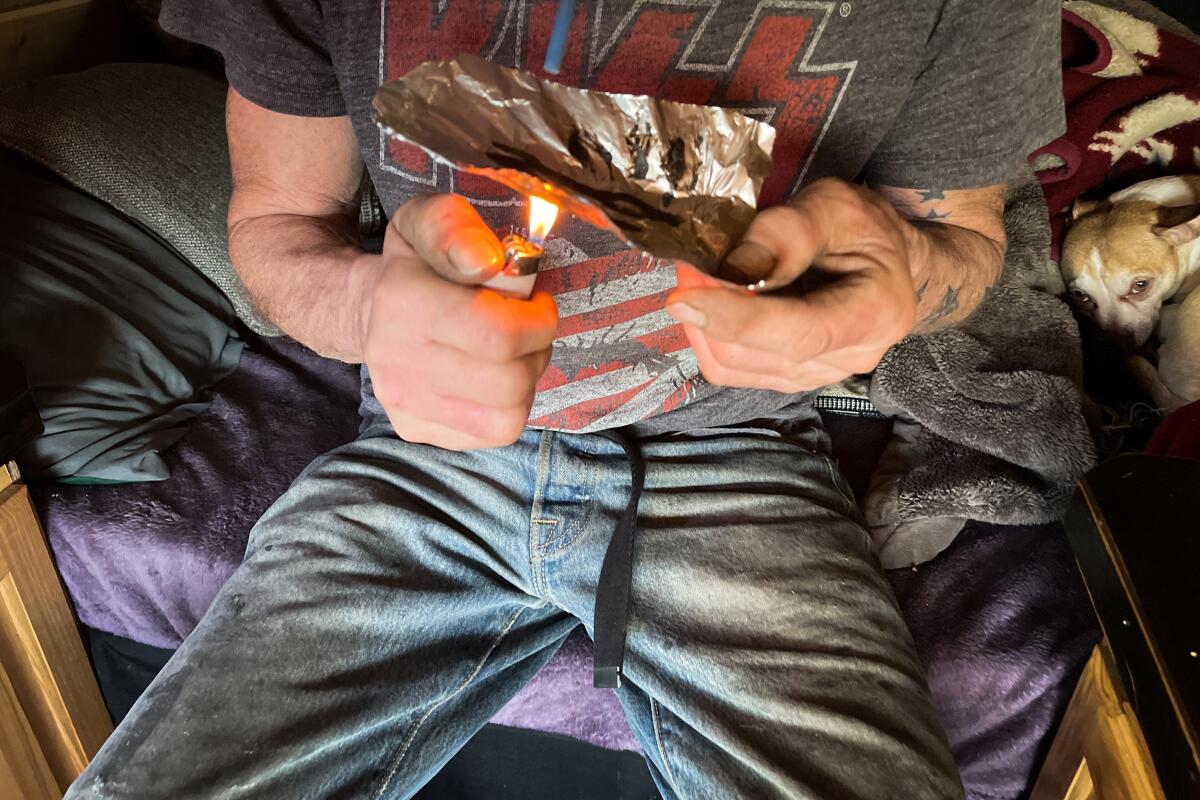
They also spoke of downsides. With the exception of the “high rollers” who can spare a few hundred for a portable generator, most of the RVers have no electricity and no hookups for septic systems. The city comes by on occasion to pump out the waste, but more often it’s illegally dumped into rivers and streets. Most of the RVs are no longer drivable; occupants have them hauled from site to site. Bennett was among dozens of people who complained about the rats that regularly chew up through the undercarriages.
“A lot of people out here are criminals, flat out,” said James Carter, 60, who became homeless after losing his job as an automotive refinish technician early in the pandemic and now lives out of a cargo van. “Stolen cars get dropped on this road constantly. There have been dead bodies.”
Carter, too, uses heroin. He and others said they support their habit by using food stamp benefits to purchase pallets of bottled water, then empty the water and recycle the bottles for cash. Some said they steal electronics from big-box stores and resell the goods. They say the retailers generally don’t try to stop them, worried about the risk of violence to their employees.
“We call it getting well, because you feel like s— until you get high,” said Carter, describing a heroin habit that costs him about $40 per day. “There’s a lot of people who need help out here.”
::
Laurelhurst Park is a forested oasis in east Portland. Situated south of the Columbia River with the mighty Willamette to the west, it spans 32 acres and features a spring-fed duck pond, running trails, tennis courts, horseshoe pits and a playground.
But the recreational areas are often littered with debris from a homeless encampment in the park that ballooned during the pandemic and has proved difficult to disband despite a series of law enforcement sweeps. Many homeowners in the surrounding neighborhood, a historical enclave of Craftsman and Colonial Revival-style homes, say they’ve been thrust into the role of vigilantes, leaning on the city to do something about the mess.
They feel Portland’s charm ebbing, as the lives of the unhoused collide with the lives of the housed.
“This used to be the most beautiful, amazing city — now people’s houses and cars are getting broken into, and you can call 911, but no one is going to come,” said TJ Browning, who chairs the public safety committee for the Laurelhurst Neighborhood Assn.
“We’re a progressive city, I’m a progressive, but the worst part is I can feel the compassion leaving,” she said. “I recognize people are self-medicating mental illness with drugs, but so many people like me just don’t care anymore. We want the criminal element out, even if it means taking people to jail.”
It’s her job to collect neighborhood complaints, and there has been no shortage as the city has allowed the amorphous encampment to take root in the park and smaller offshoots to pop up on surrounding streets. Every so often, when the neighborhood has complained enough, authorities sweep the camps, only to see them take shape once more.
- Share via
Watch L.A. Times Today at 7 p.m. on Spectrum News 1 on Channel 1 or live stream on the Spectrum News App. Palos Verdes Peninsula and Orange County viewers can watch on Cox Systems on channel 99.
One night, a propane tank exploded, causing a fire. Children have picked up used needles. Some of the homeless campers rant at parkgoers and wade into traffic. She fields calls from neighbors concerned about nighttime prowlers.
“It’s just not safe anymore,” Browning said. “It’s hard to feel compassion for the person creating the problem, when the problem is a threat to you or your family.”
Like many residents interviewed, Browning is a longtime Democrat who has watched in dismay as her liberal values give way to frustration and resentment. And she understands the good intentions, spawned by liberal policies, that brought Portland to this tipping point.
Chabria: Vancouver’s safe drug-use sites are wrenching to see. California should open them anyway
For years, this Canadian city has hosted safe consumption sites for addicts. They’ve saved lives, but with some painful tradeoffs.
They include a dedicated effort to decriminalize low-level drug possession; a shift toward “harm reduction” programs that offer addicts shelter and medical care without coercing abstinence; and court rulings that make it difficult to clear homeless encampments if the city can’t offer beds to the people displaced.
The problem is not so much the policies, in theory, as it is how they play out in Portland’s broader reality. Drug users stay out of jail, but Oregon has too few drug treatment programs and no easy way to mandate participation. Advocates for the homeless ardently protest efforts to roust the encampments, arguing that people have nowhere else to go.
And cuts to police services have left housed residents feeling they are on their own to deal with the repercussions.
In recent years, Portland has made major cuts to police funding, spurred in part by the movement to defund police and shift resources into economic development and social services. In 2020, the Portland Police Bureau took a funding cut of $26.9 million and eliminated officer positions assigned to a gun violence reduction team, narcotics, organized crime, neighborhood safety, schools and traffic patrol.
There are 774 sworn officers in Portland today, down from 934 in 2020.
“The Police Bureau is the smallest it has been in modern times, with fewer sworn members than any time in anyone’s memory,” said Sgt. Kevin Allen, a spokesperson for the bureau.
“It is not surprising that people believe they aren’t seeing as quick a response, or as many officers on patrol — because there aren’t as many. We have to prioritize what we can do based on our resources.”
With crime on the rise — property crimes are up 33% over last spring, and homicides last year eclipsed a three-decade record — Mayor Wheeler has restored some of the funding as part of a broader investment in public safety. But residents say they can’t rely on police to respond to emergency calls.
“If nobody is dying,” Browning said, “no police officer is going to show up.”
In some ways, Portland’s liberal constituency is at war with itself, the devout at odds with the disillusioned.
“We want a more holistic solution to support people out here, and for this neighborhood to be livable regardless if you are housed or unhoused,” said Matchu Williams, a volunteer with the Mt. Scott-Arleta Neighborhood Assn.
Williams is helping lead efforts to bring in more public restrooms, free shower services at a community center, and “community care cabinets” with donated items such as toothbrushes and canned vegetables. “This is just neighbors coming together buying what they can to put in here, and it’s usually stocked full,” he said. “It’s small, but meaningful.”
Williams gives voice to another core constituency in Portland who say the city has a responsibility to ease the burden of living homeless, while also investing more energy and resources to address the affordable housing shortage he sees as the genesis of the problem. On a brisk spring day, walking past the slick coffee shops and brew houses that have made Mt. Scott-Arleta a draw, he recounted the city’s difficult slog pushing through a 100-unit affordable housing complex in his neighborhood.
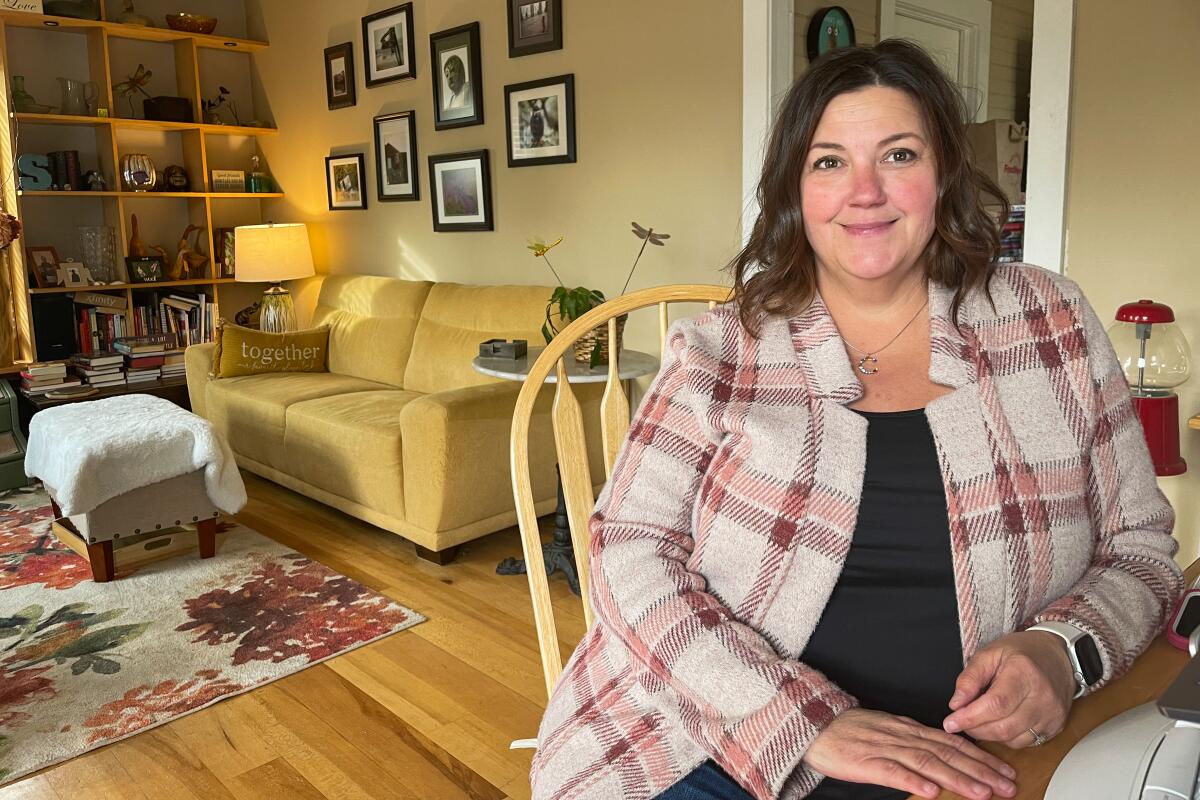
Portland residents are quick to approve funding for homeless services, he noted, but more resistant when it comes to supporting sites for low-income and homeless housing.
“There’s been a lot of frustration with how slow things are moving,” Williams said. “It’s important to understand how we got here, but also how we get out of it.”
Others, like Cindy Stockton, whose north Portland neighborhood sits at the confluence of the Willamette and Columbia rivers, wonder if there are lessons to be gleaned from more conservative cities. Phoenix, for example, takes a less accommodating approach to encampments.
People living homeless are steered to a loosely designated encampment in the city center that is cordoned off by chain barriers and patrolled by police, as KHN observed during a visit to Phoenix. Campers are supplied with food, water, sanitary facilities and medical treatment. But the arrangement comes with the understanding that camping generally is tolerated only within those boundaries.
“I’m a lifelong Democrat, but I find myself wondering if we need to elect Republicans,” Stockton said. “We’ve been Democratic-led for so long in this state, and it’s not getting us anywhere.”
Browning, in Laurelhurst, described a similar transformation: “I look in the mirror and I see a hippie — but a hippie wouldn’t be advocating for more police.”
“I wonder, what the hell happened to me?”
::
Buffeted by the political crosswinds of Portland’s homelessness dilemma, Mayor Wheeler is looking to adjust course. Wheeler, who took office in 2017, was elected as part of a wave of progressive politicians seen as standard-bearers for a more socially conscious approach to social ills.
That has meant a focus on police reform, and a host of programs anchored in the concept that people living homeless, addicted, or with untreated mental illness are victims of a broken system. Rather than blaming them for their plight, the idea is to meet their immediate needs with sensitivity while working to get them services to address the issues that put them on the street.
In vogue is a push to create permanent housing options with wraparound services that can start before someone is stable or sober; frowned upon are the old-school emergency shelters with curfews and drug bans that many advocates denounce as warehousing.
But it takes time — and funding and zoning changes and neighborhood buy-in — to design and approve sites for the longer-term programs. Portland’s homeless population has outpaced the city’s efforts.
“Fentanyl is making the rounds, and we have a major meth and heroin problem,” Wheeler said. “There are a lot of people living on the edge, and more and more are living in their RVs. It’s a catastrophe for people living on the streets, and they are absolutely traumatized, but we also acknowledge that this creates a problem for the entire community — for public safety and the environment.”
“There are a lot of people living on the edge, and more and more are living in their RVs. It’s a catastrophe... they are absolutely traumatized.”
— Portland Mayor Ted Wheeler
In the short term, Wheeler said, Portland is trying to address the public health risks by installing public restrooms and hygiene stations and offering RV sewage services. He has riled some liberal allies by adopting the stance that the city has an obligation to clear out more encampments and move people into emergency shelters for their own health and safety.
Wheeler’s budget for the coming year, recently approved by the City Council, calls for 10 new shelter programs offering nearly 600 beds. He wants to reserve 130 apartments for people living homeless and 200 motel rooms for older homeless people with chronic conditions, and to expand drug treatment options. Most controversial, the city would funnel $36 million over two years to help create eight “safe-rest villages,” a mix of tiny homes and RV parking with support services and space for up to 1,500 people.
The proposal is mired in controversy, with many neighborhood groups opposed. At the same time, Wheeler said, “I am hearing overwhelmingly from the people in this city that they do not want to simply criminalize homeless people and throw them in jail because they are homeless. I don’t think that’s a real solution.”

Larry Bixel, who lives in a 1987-issue Fleetwood Bounder near Delta Park, has his doubts about the city’s ability to put a dent in the homeless numbers, much as he’d like a real house. “I don’t recognize Portland anymore,” he said. “There’s tents all along the freeway. It’s the pills and drugs everywhere.”
A former car salesman, Bixel, 41, said his free fall into homelessness started after he got addicted to painkillers prescribed for a shoulder tear sustained while playing softball at Delta Park nearly 20 years ago. He progressed from Vicodin to OxyContin to heroin, a cheaper habit that his wife also took up. Life spiraled as he wrecked his car and racked up felony convictions. Over time, the couple lost their jobs, their home and custody of their three young children.
“I went from painkillers after the accident to addiction taking over my life,” he said.
But Bixel hasn’t given up on himself. He thinks with the right opportunities — a job, a landlord willing to take a chance on him — he could find the motivation to get clean again.
“My wife and I, we’re looked at like scum now,” Bixel said. “But honestly, this is also one of the best things that has happened to me. I used to look down at homeless people for not having a job, and if somebody asked me for change, I’d say, ‘I worked hard for this.’
“Now, if someone asks me for a cigarette, I’ll give them two.”
KHN (Kaiser Health News) is one of the three major operating programs at KFF (Kaiser Family Foundation), an endowed nonprofit organization.
More to Read
Sign up for Essential California
The most important California stories and recommendations in your inbox every morning.
You may occasionally receive promotional content from the Los Angeles Times.
